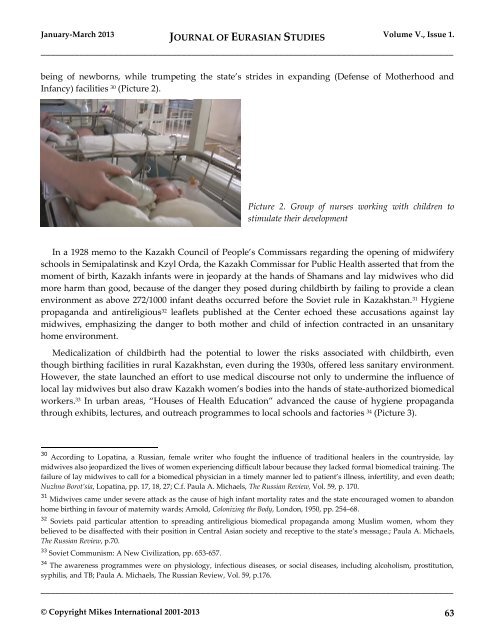JOURNAL OF EURASIAN STUDIES Journal of the Gábor Bálint de ...
JOURNAL OF EURASIAN STUDIES Journal of the Gábor Bálint de ...
JOURNAL OF EURASIAN STUDIES Journal of the Gábor Bálint de ...
You also want an ePaper? Increase the reach of your titles
YUMPU automatically turns print PDFs into web optimized ePapers that Google loves.
January-March 2013 <strong>JOURNAL</strong> <strong>OF</strong> <strong>EURASIAN</strong> <strong>STUDIES</strong> Volume V., Issue 1.<br />
_____________________________________________________________________________________<br />
being <strong>of</strong> newborns, while trumpeting <strong>the</strong> state’s stri<strong>de</strong>s in expanding (Defense <strong>of</strong> Mo<strong>the</strong>rhood and<br />
Infancy) facilities 30 (Picture 2).<br />
Picture 2. Group <strong>of</strong> nurses working with children to<br />
stimulate <strong>the</strong>ir <strong>de</strong>velopment<br />
In a 1928 memo to <strong>the</strong> Kazakh Council <strong>of</strong> People’s Commissars regarding <strong>the</strong> opening <strong>of</strong> midwifery<br />
schools in Semipalatinsk and Kzyl Orda, <strong>the</strong> Kazakh Commissar for Public Health asserted that from <strong>the</strong><br />
moment <strong>of</strong> birth, Kazakh infants were in jeopardy at <strong>the</strong> hands <strong>of</strong> Shamans and lay midwives who did<br />
more harm than good, because <strong>of</strong> <strong>the</strong> danger <strong>the</strong>y posed during childbirth by failing to provi<strong>de</strong> a clean<br />
environment as above 272/1000 infant <strong>de</strong>aths occurred before <strong>the</strong> Soviet rule in Kazakhstan. 31 Hygiene<br />
propaganda and antireligious 32 leaflets published at <strong>the</strong> Center echoed <strong>the</strong>se accusations against lay<br />
midwives, emphasizing <strong>the</strong> danger to both mo<strong>the</strong>r and child <strong>of</strong> infection contracted in an unsanitary<br />
home environment.<br />
Medicalization <strong>of</strong> childbirth had <strong>the</strong> potential to lower <strong>the</strong> risks associated with childbirth, even<br />
though birthing facilities in rural Kazakhstan, even during <strong>the</strong> 1930s, <strong>of</strong>fered less sanitary environment.<br />
However, <strong>the</strong> state launched an effort to use medical discourse not only to un<strong>de</strong>rmine <strong>the</strong> influence <strong>of</strong><br />
local lay midwives but also draw Kazakh women’s bodies into <strong>the</strong> hands <strong>of</strong> state-authorized biomedical<br />
workers. 33 In urban areas, “Houses <strong>of</strong> Health Education” advanced <strong>the</strong> cause <strong>of</strong> hygiene propaganda<br />
through exhibits, lectures, and outreach programmes to local schools and factories 34 (Picture 3).<br />
30 According to Lopatina, a Russian, female writer who fought <strong>the</strong> influence <strong>of</strong> traditional healers in <strong>the</strong> countrysi<strong>de</strong>, lay<br />
midwives also jeopardized <strong>the</strong> lives <strong>of</strong> women experiencing difficult labour because <strong>the</strong>y lacked formal biomedical training. The<br />
failure <strong>of</strong> lay midwives to call for a biomedical physician in a timely manner led to patient’s illness, infertility, and even <strong>de</strong>ath;<br />
Nuzhno Borot’sia, Lopatina, pp. 17, 18, 27; C.f. Paula A. Michaels, The Russian Review, Vol. 59, p. 170.<br />
31 Midwives came un<strong>de</strong>r severe attack as <strong>the</strong> cause <strong>of</strong> high infant mortality rates and <strong>the</strong> state encouraged women to abandon<br />
home birthing in favour <strong>of</strong> maternity wards; Arnold, Colonizing <strong>the</strong> Body, London, 1950, pp. 254–68.<br />
32 Soviets paid particular attention to spreading antireligious biomedical propaganda among Muslim women, whom <strong>the</strong>y<br />
believed to be disaffected with <strong>the</strong>ir position in Central Asian society and receptive to <strong>the</strong> state’s message.; Paula A. Michaels,<br />
The Russian Review, p.70.<br />
33 Soviet Communism: A New Civilization, pp. 653-657.<br />
34 The awareness programmes were on physiology, infectious diseases, or social diseases, including alcoholism, prostitution,<br />
syphilis, and TB; Paula A. Michaels, The Russian Review, Vol. 59, p.176.<br />
_____________________________________________________________________________________<br />
© Copyright Mikes International 2001-2013 63

















